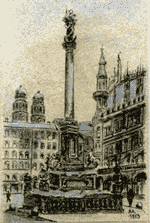Washington DC, Sunday, April 21, 2002 (page W26)
The Art of Evil Half a century later, the paintings of Adolf Hitler are still a federal case By Marc Fisher
THE best of the paintings shows a war-torn streetscape -- a lamppost leaning away from a shrapnel-nicked brick building. The background reveals the facade of a gutted church, its purpose burned away. There is no one on the street; life has been chased, bombed, swept from this Belgian village where the soldier-artist found such devastation. The artist was good enough to make his living at this for some years. But he realized he was not going to make his mark as a painter. He changed careers and became far more successful in another line of work. His name was Adolf Hitler. The United States of America claims ownership of these four Hitler watercolors. So does an art collector in Texas who bought the rights to the paintings from the children of Hitler's personal photographer. A lawsuit over the watercolors has been slouching through federal courts in Texas and Washington for 18 years. There are lawyers who spent much of their careers on the case, retired and still come back to the office to work on it. Some of the most important witnesses have died while the case drags on. Billy Price, the Texas collector who first filed suit against the government, has long since sold off his collection of Hitler art and World War II memorabilia -- someone who didn't like the idea of collecting Hitler's paintings put a bullet into Price's office one day, and that was enough for him. But the lawyers push on, and so do their clients -- Price and the descendants of Heinrich Hoffmann, Hitler's friend and photographer. And all around the country, there is a busy and lucrative trade in Hitler's artwork -- mostly watercolors, a few oils, lots of hand-painted postcards (some of which were actually sent and include birthday salutations and wish-you-were-here vacation greetings on the flip side), and a few 1-by-2-inch miniatures that reveal an obsession with architectural detail.
Those who work to keep the horror of the Holocaust and the crimes of Hitler fresh and meaningful fear that the Fuehrer and symbols of him -- the black-and-white footage, endlessly repeated; the mustache, forever imitated; the wild gestures and barking rhetoric, ceaselessly mocked -- will devolve into a crass commercialization that sweeps away memories of the horror. These people worry that Hitler's art might be used to promote new bouts of extremism and hate -- which is exactly why Hitler's art is banned in Germany, as are swastikas, Nazi regalia and even Mein Kampf. Fear of resurgent nationalism still drives policy in Hitler's homeland, even after half a century of democracy.
"We understand that some artifacts are sensitive to some people, and we offer these specimens with this in mind," says a policy statement on the Web site of Manion's International Auction, purveyor of Hitler bronze wall plaques ($39), a swastika-adorned paper lantern ($75), a Hitler wall tapestry (asking $390; no bids), and an original oil painting of the Fuehrer, signed by the artist (asking $2,000). But prices jump markedly if the offering is something from Hitler's own hand, if it is a vision from the dictator's mind, a glimpse into the artist who might have been, into the reality that might have followed, if only the young painter had risen above his art school rejection and persisted in the career he had chosen as a boy, the path that had so outraged his father, the identity that Hitler would cling to throughout his life. Adolf Hitler, artist. What does it mean now, half a century later, to own a Hitler, to hang it in a place of honor in your front hall, to secure it in an annex to your house, to want it so badly that you fight the government for decades for the right to call it your own? What does it say about you, about the culture in which you live, and about what Hitler is and will be? From a 1937 book of Adolf Hitler aquarelles, published by a Nazi Party publishing house: Hitler "is at once the First Fuehrer and the First Artist of our Reich."
Hitler once said he painted more than 1,000 pieces while living in Vienna from 1909 to 1914. A U.S. government report once put Hitler's total output at closer to 3,000 works. No good accounting of the pieces has been made. Collectors around the world consider any group of 20 or more Hitlers to be a fair-size collection. Snyder has bought and sold more than 100 pieces, at prices mostly in the $5,000 to $10,000 range. The Hitler business, like the rest of Snyder's Treasure Trove, as it's known to its customers, was once a very public, social sort of endeavor -- road shows, a regular annual circuit around the country. EBay put an end to all that. No reason to leave the house anymore. "We get almost a million hits a month," announces Snyder, a muscular, correct man with close-cropped white hair and a mustache. "It's saved our lives." Forget the trucks -- Snyder's tools of the trade now are ergonomic neck cushions and anti-repetitive strain injury wrist straps. Snyder has been a collector since 1962. "It's a disease and you can't stop," he says. At 70, he is, like many collectors, old enough to remember the war. It was indeed World War II stuff that first got him hooked on the collectibles biz -- uniforms, weapons, Eva Braun's tea service, Nazi autographs, swastika cuff links, Hitler's silver, Hitler's desk ornaments, and then, finally, Hitler's art. At one point a few years ago, Snyder owned 40 Hitlers. He's down to 11 watercolors, a bunch of postcards and one large oil, a dark portrait of a cathedral under a mottled brown sky. It is signed "Adolf Hitler" and dated 1936. "He was kind of busy then," Snyder says. The oil hangs just inside his front door, next to autographed photos of Gerald Ford and Ronald Reagan. Don't be distracted by the homey look: Everything is for sale. He wants $35,000 for the oil.
American soldiers carried out their war booty by the trunkful. Watts snared hundreds of pieces of silverware, thousands of documents and more than 30 original Hitler paintings. "We won, so it's ours," is Snyder's explanation. "That's why guys bring stuff back. It's, 'Gee, Mom, I was there.' " Snyder buys from anyone; he once picked up a Hitler from Albert Speer, the Fuehrer's architect. Snyder paid $500 for a Hitler sketch for a German pavilion at the proposed 1942 World's Fair. The major later sold it for $1,000. Business. Snyder has pencil sketches of Linz, Austria, Hitler's home town. He has the postcards. Snyder doesn't especially like Hitler's painting. In his catalogue of his collection, he writes of the Hitler works, "People and animals are out of proportion, poorly articulated, and vastly out of scale with the backgrounds. Figures are rendered with wanton disregard for anatomy or accurate animation." All of which has nothing to do with Snyder's regard for the value of his Hitlers. They're merchandise. Most of his customers see it the same way: One of Snyder's friends liked one Hitler so much, he scanned it into his computer to use as a screen saver. But other customers don't care what the painting looks like as long as it's a Hitler, and still others just don't talk about why they want what they want. And Snyder never asks.
Snyder won't identify most of his customers, but euthanasia advocate Jack Kevorkian, "Dr. Death," was one. Had a nice little Hitler collection there for a while. For what it's worth. Snyder doesn't spend a lot of time trying to figure out Hitler the artist or Hitler the genocidal dictator. He has product to move. "Our job is to place these things with collectors who will really appreciate them," he says. Nor is he ever creeped out by having all this Hitler stuff all over his house, even in the bedroom. "You get used to creepiness, being a warrior. Which is unfortunate, but you do. I used to have mannequins upstairs, World War I aviators, and it just got too weird, my wife didn't like it, so I took them downstairs." Where they stare at him all day. He will say this: "There is more of a fascination with
bad guys than with good guys." Churchill and
Eisenhower painted, too. "You don't see much of their
work, and there's not much demand." But the demand for
Hitler art shows no sign of waning. It's only when he starts
going through old photographs of the war that Snyder relates
all this to his own years in the military. "The further away
you get from a terrible experience, the better it seems," he
says suddenly. And he tears up. Related item on this website: |

